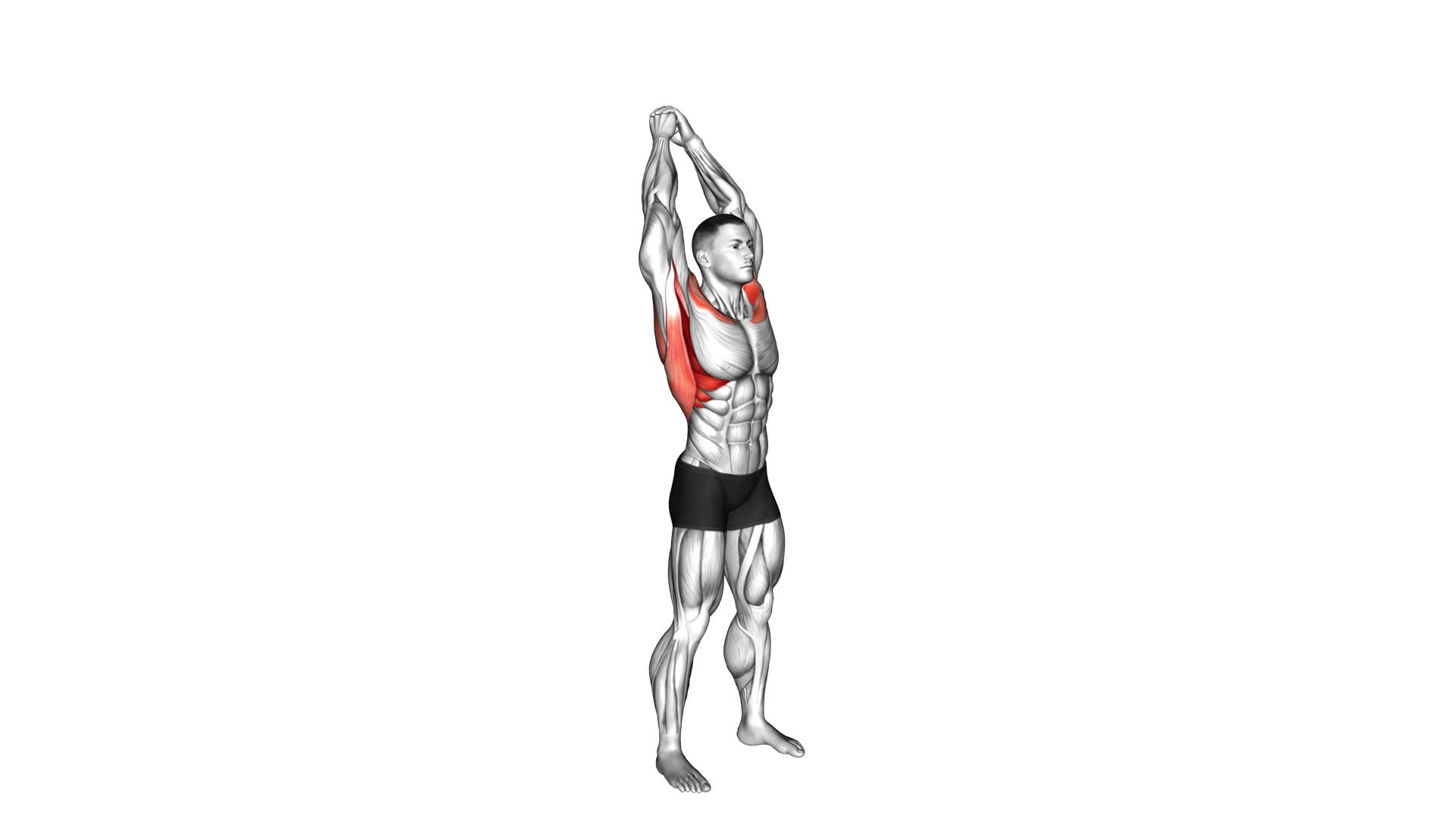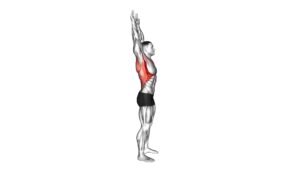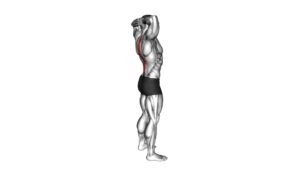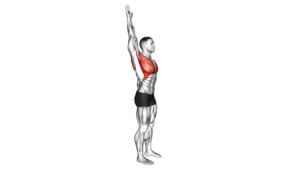Shoulder Backbend Stretch (VERSION 2) – Video Exercise Guide & Tips

Get ready to improve your flexibility and strengthen your shoulders with the Shoulder Backbend Stretch.
Watch This Exercise Video
In this video exercise guide, you'll learn the proper technique and get helpful tips to maximize the benefits of this stretch.
Whether you're a beginner or advanced, there are modifications and variations for all skill levels.
Remember to stay safe and follow the precautions outlined in this article.
Let's get started and take your shoulder mobility to the next level!
Key Takeaways
- The shoulder backbend stretch improves shoulder flexibility and posture.
- It increases range of motion in the shoulders and strengthens muscles around the shoulder joint.
- The stretch promotes better stability and reduces the risk of injuries.
- It relieves tension and tightness in the upper back and neck.
Benefits of the Shoulder Backbend Stretch
You can experience numerous benefits from incorporating the shoulder backbend stretch into your exercise routine. This stretch is highly effective in improving shoulder flexibility and posture. By regularly performing the shoulder backbend stretch, you can increase the range of motion in your shoulders, allowing for better mobility and flexibility. This is especially beneficial for individuals who engage in activities that require overhead movements, such as weightlifting or swimming.
Additionally, the shoulder backbend stretch helps to strengthen the muscles around the shoulder joint, promoting better stability and reducing the risk of injuries.
Improved posture is another key benefit of the shoulder backbend stretch. By stretching the muscles in the chest, shoulders, and upper back, this exercise helps to counteract the effects of slouching and rounded shoulders. By incorporating the shoulder backbend stretch into your routine, you can encourage proper alignment of the spine and shoulders, leading to a more upright and confident posture.
Now that you understand the benefits of the shoulder backbend stretch, let's move on to discussing the proper technique for performing the stretch.
Proper Technique for Performing the Stretch
To perform the shoulder backbend stretch with proper technique, start by lying on your back. Follow these steps to ensure you're performing the stretch correctly:
- Begin by bending your knees and placing your feet flat on the floor, hip-width apart.
- Place your hands on the floor beside your shoulders, fingers pointing towards your feet.
- Press into your hands and lift your shoulders off the ground, allowing your head to gently drop back.
- Engage your core muscles to support your lower back and keep your hips on the ground.
- Hold the stretch for 15 to 30 seconds, focusing on deep, controlled breathing.
It's important to be aware of common mistakes when performing the shoulder backbend stretch. Avoid these errors to maximize the effectiveness and safety of the stretch:
- Arching your lower back excessively, which can strain the lumbar spine.
- Allowing your hips to lift off the ground, which takes away from the stretch in your shoulders.
- Holding your breath instead of maintaining a steady breathing pattern.
To gain the most benefit from the shoulder backbend stretch, it's recommended to hold the stretch for 15 to 30 seconds and repeat it 2 to 3 times on each side. Remember to listen to your body and make adjustments as needed to ensure proper form and avoid discomfort or pain.
Modifications and Variations for All Skill Levels
Continue the discussion on modifications and variations for all skill levels by exploring different ways to adapt the shoulder backbend stretch. Whether you're a beginner looking for modifications or an advanced practitioner seeking more challenging variations, there are options available to suit your needs.
For beginners, it's important to start with modifications that allow you to safely and comfortably perform the shoulder backbend stretch. One modification is to use a prop, such as a yoga block or bolster, to support your back and shoulders. This can help alleviate any strain or discomfort while still allowing you to benefit from the stretch. Another modification is to perform the stretch with bent knees instead of straight legs. This reduces the intensity of the stretch and makes it more accessible for beginners.
On the other hand, advanced practitioners can explore variations that take the shoulder backbend stretch to the next level. One advanced variation is to add a twist to the stretch by reaching one arm across the body and placing it on the opposite knee. This deepens the stretch and engages the muscles in the torso and obliques. Another advanced variation is to lift one leg off the ground while performing the stretch, adding an element of balance and strengthening the core.
Tips for Getting the Most Out of the Stretch
To maximize the benefits of the shoulder backbend stretch, regularly incorporate these tips into your practice:
- Pay attention to your form: It's important to maintain proper form during the stretch to avoid injury and ensure maximum effectiveness. Keep your shoulders relaxed and your chest lifted as you gently arch your upper back.
- Start slowly: When first attempting the shoulder backbend stretch, start with a small range of motion and gradually increase it over time. This will help your body adjust and prevent strain.
- Listen to your body: If you feel any pain or discomfort during the stretch, ease off or modify the movement. It's important to honor your body's limitations and not push yourself too far.
- Avoid these common mistakes: Don't force the stretch or use momentum to achieve a deeper backbend. Instead, focus on controlled movements and engage your core for stability.
- Recommended duration: Hold the shoulder backbend stretch for 15-30 seconds, breathing deeply and relaxing into the stretch. Repeat for 2-3 sets.
Precautions and Safety Measures to Consider
When practicing the shoulder backbend stretch, it's important to take certain precautions and safety measures to prevent injuries. Before attempting this stretch, it's crucial to warm up your body with appropriate exercises. This helps to increase blood flow to the muscles and joints, making them more flexible and less prone to injury.
Start by performing some dynamic stretches such as arm circles, shoulder rolls, and neck rotations. These movements help to loosen up the upper body and prepare it for the more intense shoulder backbend stretch. Additionally, incorporate some light cardio exercises like jogging or jumping jacks to increase your heart rate and warm up your entire body.
When performing the shoulder backbend stretch, be mindful of your body's limitations. Avoid pushing yourself too far or too quickly, as this can lead to strain or injury. Listen to your body and only go as far as feels comfortable for you. Remember to maintain proper form throughout the stretch, keeping your core engaged and your spine aligned.
It is also important to avoid any jerking or bouncing movements during the stretch. Instead, move slowly and smoothly, allowing your muscles to gradually lengthen and stretch. If you experience any pain or discomfort, stop immediately and consult with a qualified fitness professional or healthcare provider.
Frequently Asked Questions
How Long Should I Hold the Shoulder Backbend Stretch?
To get the most out of the shoulder backbend stretch, it's important to hold it for an appropriate amount of time. When starting out, aim for 20-30 seconds and gradually increase as you become more comfortable.
This allows your muscles to stretch and improve flexibility without causing strain or injury. Holding this stretch regularly can benefit your daily routine by helping to relieve tension in the shoulders, improve posture, and increase range of motion.
Can the Shoulder Backbend Stretch Help With Improving Posture?
The shoulder backbend stretch can definitely help improve your posture by improving alignment and strengthening your back muscles.
By stretching and opening up the chest and shoulders, this exercise can counteract the effects of slouching and sitting for long periods of time.
It helps to lengthen the spine, release tension in the upper back, and promote better posture overall.
Incorporating this stretch into your routine can greatly contribute to improving your posture and maintaining a healthy alignment.
Is It Normal to Feel Discomfort or Tightness During the Stretch?
Feeling discomfort or tightness during a stretch is normal. It indicates that the muscles are being stretched and worked. However, it's important to listen to your body and not push through pain. If the discomfort becomes too intense or unbearable, it's advisable to stop the stretch.
There are various stretching techniques you can try as alternatives to the shoulder backbend stretch, such as shoulder rolls, chest openers, or doorway stretches. These can also help improve posture and flexibility.
Can the Shoulder Backbend Stretch Help With Relieving Shoulder Pain?
Yes, incorporating the shoulder backbend stretch into your daily routine can potentially help with relieving shoulder pain. It's important to note that there are alternative methods for shoulder pain relief as well.
However, the shoulder backbend stretch can provide benefits such as improving flexibility, increasing range of motion, and releasing tension in the shoulder muscles.
It's always advisable to consult with a healthcare professional before starting any new exercise or stretching routine.
Are There Any Specific Breathing Techniques That Should Be Used During the Shoulder Backbend Stretch?
During the shoulder backbend stretch, it's important to focus on your breathing. Breathing deeply and fully can help you relax and enhance the stretch.
Take a deep breath in as you lift your chest and arch your back, and exhale as you release the stretch. This will help you connect with your body and find more ease in the movement.
Conclusion
In conclusion, the shoulder backbend stretch is a beneficial exercise for improving flexibility and relieving tension in the upper body. By following the proper technique and incorporating modifications for different skill levels, individuals can safely perform this stretch.
Remember to listen to your body and adjust accordingly, and always consult with a healthcare professional before starting any new exercise routine. Incorporating this stretch into your fitness regimen can help you achieve better mobility and overall well-being.

Author
Years ago, the spark of my life’s passion ignited in my mind the moment I stepped into the local gym for the first time. The inaugural bead of perspiration, the initial endeavor, the very first surge of endorphins, and a sense of pride that washed over me post-workout marked the beginning of my deep-seated interest in strength sports, fitness, and sports nutrition. This very curiosity blossomed rapidly into a profound fascination, propelling me to earn a Master’s degree in Physical Education from the Academy of Physical Education in Krakow, followed by a Sports Manager diploma from the Jagiellonian University. My journey of growth led me to gain more specialized qualifications, such as being a certified personal trainer with a focus on sports dietetics, a lifeguard, and an instructor for wellness and corrective gymnastics. Theoretical knowledge paired seamlessly with practical experience, reinforcing my belief that the transformation of individuals under my guidance was also a reflection of my personal growth. This belief holds true even today. Each day, I strive to push the boundaries and explore new realms. These realms gently elevate me to greater heights. The unique combination of passion for my field and the continuous quest for growth fuels my drive to break new ground.







